Granted, that’s true of any photograph, and indeed any blog, but it’s just more fun to sound arrogant sometimes.
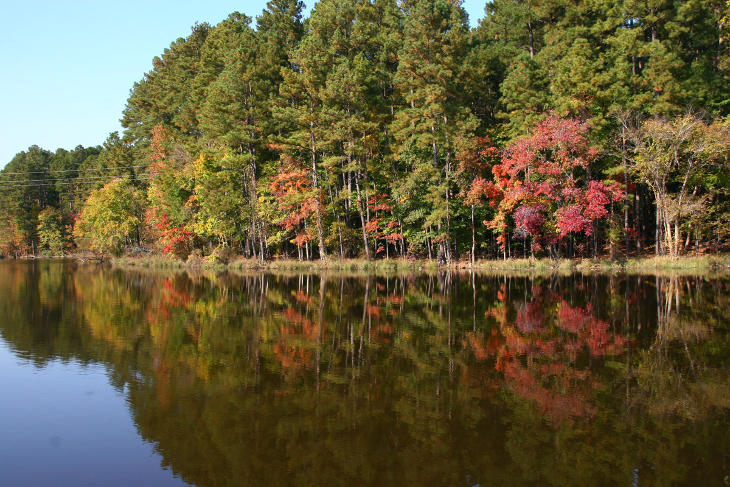
But what is being demonstrated here is a common trait of autumn colors, and something that can be applied to all photography. This area is unfortunately dominated by longneedle pine trees, which don’t change color and tend to be pretty ugly as trees go – and also tall. So there’s little opportunity for sweeping vistas of fall color, even if the deciduous trees were cooperative enough to all reach peak coloration at the same time, which they are not. What we get are splashes of color here and there, usually set against and among the pines. So to have images that express “autumn” to viewers, around here at least, one has to be selective in their approach. This photo kind of splits the difference: on initial glance it seems to show colors halfway decently, but after a moment it becomes clear that the colorful trees are few, set against the boring ones. Had I framed wider either horizontally or vertically, the few bright trees would have appeared even less imposing.
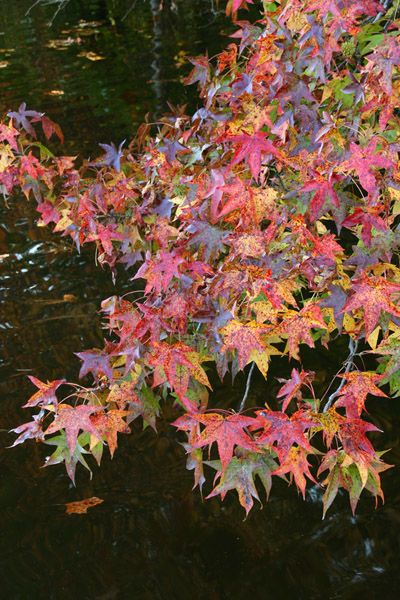 Another example is this American sweetgum (Liquidambar styraciflua) at the same location, a lone tree among a lot of greenery that showed off a patchwork quilt of colors all by itself. A broader landscape shot would only have diminished the impact of the colors and would hardly have expressed “fall” in any significant way, so going in close was necessary to bring the impact of the contrasting colors. The sweetgum, and a couple varieties of maple, seem to be the only species in the area that develop vivid reds before shedding the leaves, but I could be wrong about that – identifying trees has never been my strong point. Mostly, what we see are yellows and browns, so fall colors tend to still be almost monochromatic until we stumble upon one of the more colorful trees.
Another example is this American sweetgum (Liquidambar styraciflua) at the same location, a lone tree among a lot of greenery that showed off a patchwork quilt of colors all by itself. A broader landscape shot would only have diminished the impact of the colors and would hardly have expressed “fall” in any significant way, so going in close was necessary to bring the impact of the contrasting colors. The sweetgum, and a couple varieties of maple, seem to be the only species in the area that develop vivid reds before shedding the leaves, but I could be wrong about that – identifying trees has never been my strong point. Mostly, what we see are yellows and browns, so fall colors tend to still be almost monochromatic until we stumble upon one of the more colorful trees.
It’s this kind of thing that almost forces me to select the autumn compositions that I do, but also that it’s a little trite to shoot nothing but landscapes of multi-colored trees; that’s what people expect, and what the vast majority of images from this time of year show. Areas with maples and aspens will always be more dramatic than what is available locally, but there are other ways of expressing the season and providing visual impact than broad landscape shots, and below sits another example. Though this style is enough of a favorite of mine that it is becoming ‘trite’ for me, I’m still please with how the green shoots framed the flame-colored leaf, and how the grey undersides provided a different color element not often seen. This was just a tiny patch of leaves on the surface of a creek, in a quiet area where the water grew still, and I could decide which leaves and how many appeared in the frame.
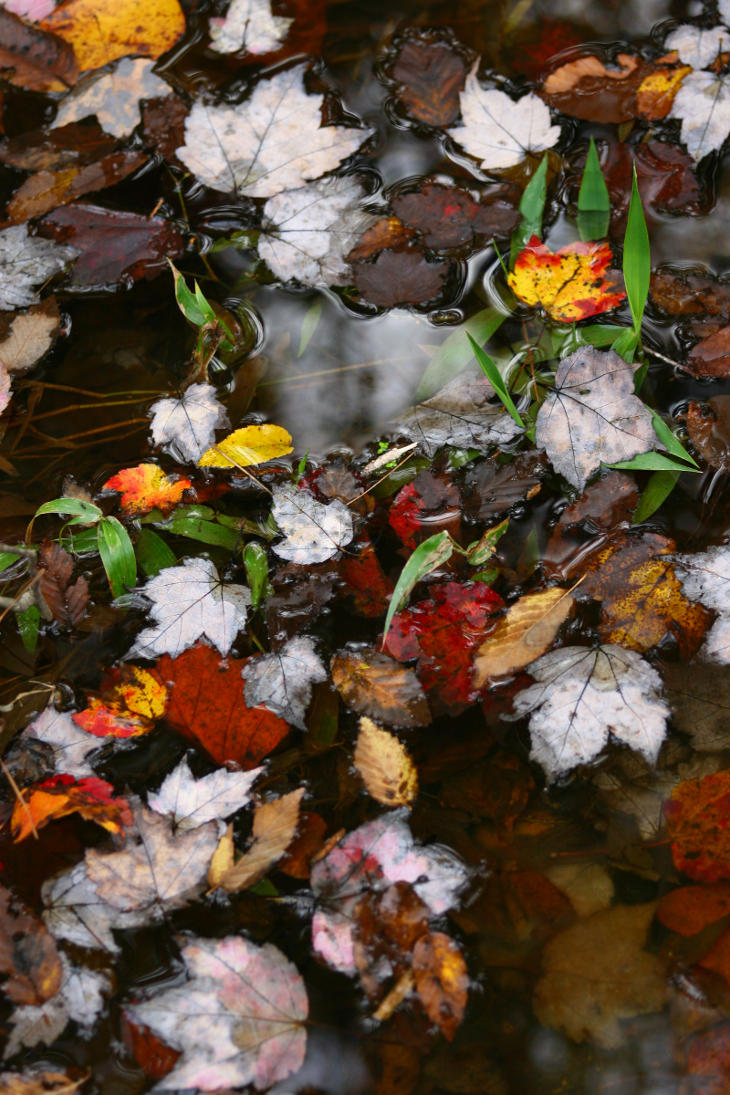
Note, too, that the light conditions helped a bit, being under enough of a forest canopy to be ‘overcast.’ Brighter light would have increased the contrast and might even have bleached out some of the colors in places, but capturing a bit of clear blue sky in the water’s reflection might have made an entirely different composition. Different elements and conditions provide for different styles and effects.
Now we get to some of the critters. Almost all of the images in this post came from two visits to the same area, the one mentioned in the previous post, an old stomping ground of mine (actually, Florida should most be considered my stomping ground, since that’s where I usually encountered fire ants and had to dislodge them from my sandals and feet – maybe I should call Florida my stomping, slapping, and cursing ground.) And there are two traits of wooded trails at this time of year. The first is, the falling leaves are quite capable of obscuring any subtle trail, to the point where finding the path can be difficult and might require some esoteric trail-spotting tricks (such as the slight swales or hollows that come from foot traffic, or the easiest openings through the underbrush that people gravitate towards.)
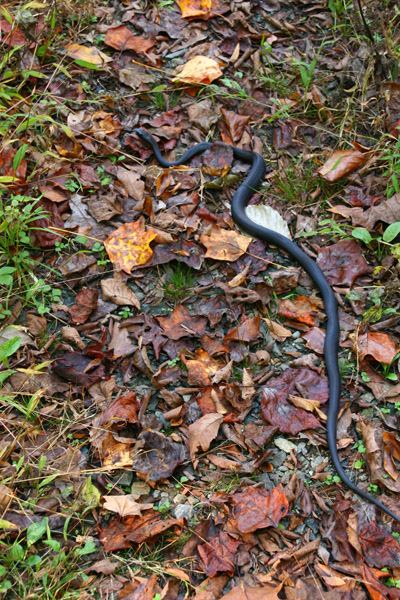 The other trait is, such ground cover can make it really hard to spot venomous snakes that have chosen to sprawl where one is walking. This image doesn’t exactly illustrate this, because this one is not at all hard to spot and also isn’t venomous: this is a black rat snake (presently Pantherophis obsoletus) that’s just shy of a meter in length. Paths are slightly more attractive to snakes at this time of year because they often present regions of low grasses or undergrowth and thus more exposed to the sun, which is important to ectothermic species when the nights gets much cooler; sidewalks and asphalt roads are more attractive still. So when it comes to species like copperheads with camouflage coloration, the risk of encountering one rises significantly, which meant I was watching my path very critically, and even more so after this one demonstrated that yes, the potential wasn’t just imaginary.
The other trait is, such ground cover can make it really hard to spot venomous snakes that have chosen to sprawl where one is walking. This image doesn’t exactly illustrate this, because this one is not at all hard to spot and also isn’t venomous: this is a black rat snake (presently Pantherophis obsoletus) that’s just shy of a meter in length. Paths are slightly more attractive to snakes at this time of year because they often present regions of low grasses or undergrowth and thus more exposed to the sun, which is important to ectothermic species when the nights gets much cooler; sidewalks and asphalt roads are more attractive still. So when it comes to species like copperheads with camouflage coloration, the risk of encountering one rises significantly, which meant I was watching my path very critically, and even more so after this one demonstrated that yes, the potential wasn’t just imaginary.
My subject here was much more cooperative than I imagined it would be. It was mid-afternoon, more than warm enough by this time, and I expected snakes to have all the energy they needed, but this one stayed put as I got the initial picture at right, then slipped slowly around it off the path and came in from the front, trying (as always) for my portrait angle. Very often, this takes some low and awkward positions, and it’s next to impossible to stay ‘clean’ when doing so, but I find the effort to be well worth it. I managed to get quite close to this one before it finally decided I was too threatening and bolted for cover. I’ve seen this kind of behavior when species are surrounded by a lot of open space, where getting into obscuring grasses takes longer and the unconcealed movement might attract predators, but this one could disappear within its own body length, so it was a little surprising. I appreciated the cooperation.
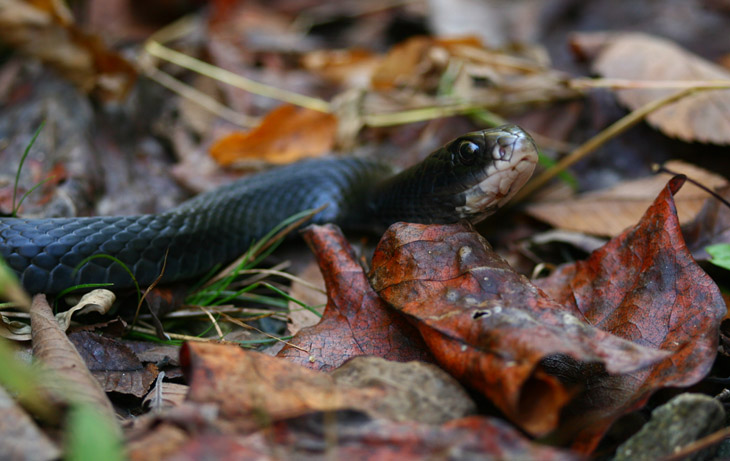
That sharp kink in the neck, drawing the head back, is a warning sign, and generally means you should keep clear, but I’ve been bitten by black rat snakes more times than I can count, despite the fact that they’re far from being a species that bites quickly (they’re much more likely to poop on you,) and the bites really are trivial. This one never attempted to strike, it was just suspicious of my slow approach from the front, which often fails to trigger the ‘danger’ signals within their brains. Had I moved faster I likely would have provoked a strike at least, even if just a half-hearted warning jab.
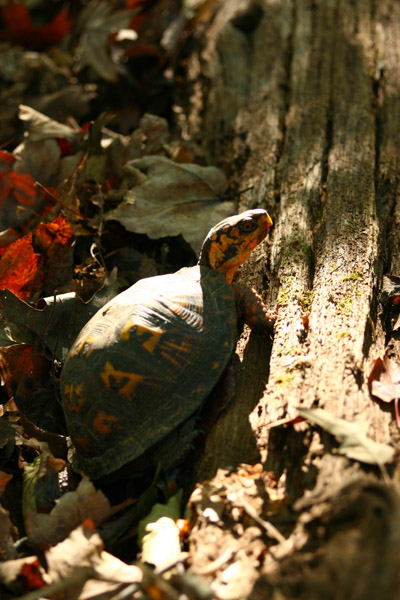 The patch of sunlight certainly helped me spot this next one, which was holding perfectly still well off the trail. It can be easy to find eastern box turtles (Terrapene carolina carolina) at this time of year because they can make a racket, relatively speaking at least, plowing through the dry leaves, but when holding still they’re better camouflaged by those same leaves. The ‘bump on a log’ with its distinctive shadow was enough to gain my attention, and I once again maneuvered around to go in for the portrait shot; the only indication from this one that it even realized I was there was to draw its head back a little when I got very close. Turtles can bite of course, and tend to have much stronger jaws than snakes, but it’s not among their first choices of defense so the risk was nonexistent, especially since I remained out of range.
The patch of sunlight certainly helped me spot this next one, which was holding perfectly still well off the trail. It can be easy to find eastern box turtles (Terrapene carolina carolina) at this time of year because they can make a racket, relatively speaking at least, plowing through the dry leaves, but when holding still they’re better camouflaged by those same leaves. The ‘bump on a log’ with its distinctive shadow was enough to gain my attention, and I once again maneuvered around to go in for the portrait shot; the only indication from this one that it even realized I was there was to draw its head back a little when I got very close. Turtles can bite of course, and tend to have much stronger jaws than snakes, but it’s not among their first choices of defense so the risk was nonexistent, especially since I remained out of range.
Before we get to the portrait, I’ll point out a couple of details that are subtly visible here. The repeating pattern on the carapace (back shell) of turtles are evidence of the scutes, essentially something like scales or plates. While interlocked, they grow individually, so each one forms a record of the turtle’s growth very much like tree rings. They’re born with the central portion, in this case marked with a backwards ‘E,’ but each year they add a ring around the outer edge that’s faintly ridged; bigger rings indicate more growth and thus a better year nutrition-wise. Some of those ridges are easily visible with the light angle, close to the turtle’s ‘shoulder,’ but they can also be seen immediately below that in the ‘sunray’ pattern – I can make out at least nine ridges, which means this one was a minimum of nine years old, probably more. One of these days I’ll provide better illustrations of this, but it’s more visible in the photos here.
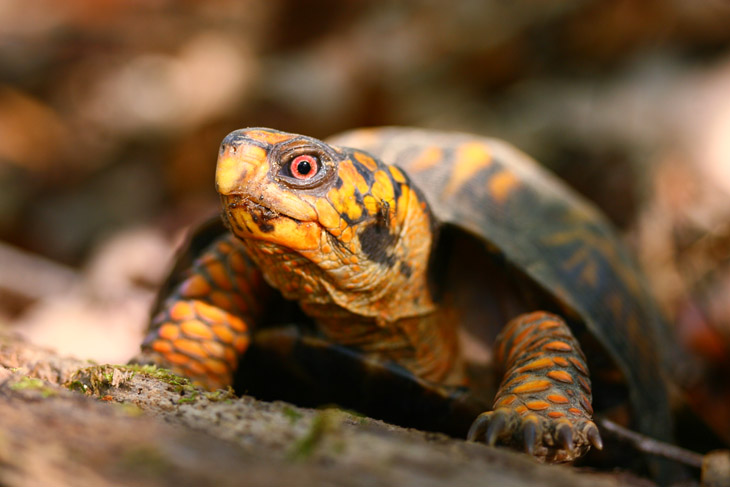
Since this one was cooperative too, I was able to go around to the side with better light for the portrait, capturing a mosquito as I did so (just above the dark patch on the face.) The red eyes indicate that this was likely a male, since the females usually have brown eyes; another indication of the gender is the plastron (belly shell) which has a distinctive indent for the males, but I didn’t pick this one up to check. You can see faint evidence of a previous meal though I couldn’t say for sure what; probably mushrooms, given the conditions.
And one last shot, from a slightly different location. While out with the impeccable Mr Bugg, we approached a pond edge slowly because we knew the conditions were right for the little frogs in the area, ones so tiny and well-camouflaged that they’re next to impossible to spot until they’re spooked and jump away. Then, of course, they’ve already been alerted to one’s presence and getting in close for the shot requires a very slow approach. I got lucky with this one, which landed in the top of a small weed and perched there; they’re usually ground-dwellers right at the edge of water, to which they can escape in a bound or two when danger threatens.

This is a cricket frog, genus Acris, but whether a southern or northern variant is hard to say because they can only be distinguished by a stripe on their inner thigh, which we did not see, or their call, which we did not hear. Given the locale, the probability leans towards the northern (Acris crepitans) rather than the southern (A. gryllus.) Some idea of the scale can be gathered from this image, but I can tell you this one was typical in size, about 15mm in body length so, you know, able to perch on your thumb. They blend in so well that, even when you might have seen them jump, it’s easy to miss them once they hold still again, so being sharp-eyed is important.
We’ll have to see how the fall colors develop, and whether I’ll be back with something more dramatic within a few days. You know where to find me.




















































